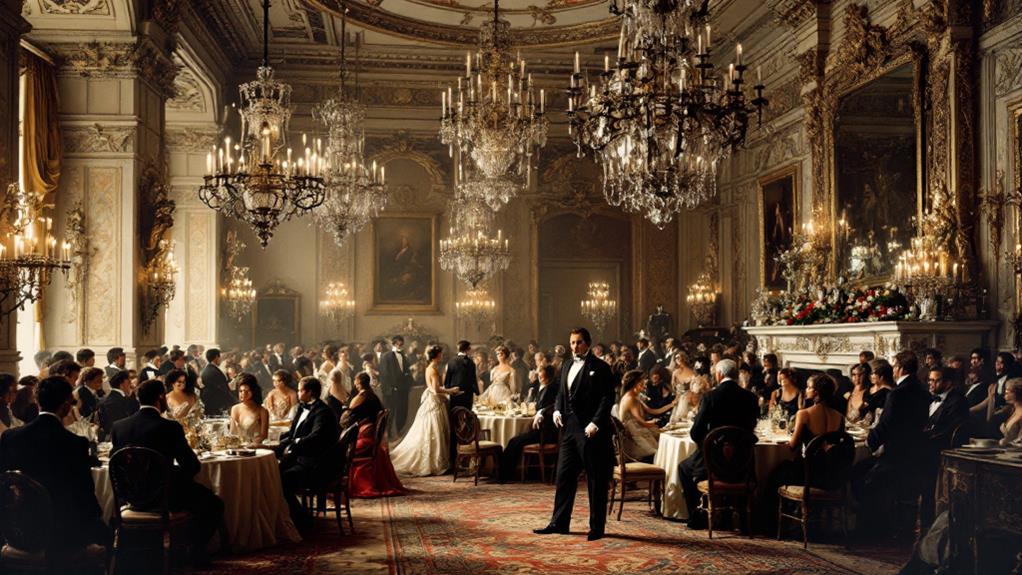How Did the Astor Family Amass Their Wealth?

The Astor family's wealth began with Johann Jakob Astor's success in the fur trade, where he dominated the North American market with the American Fur Company. Astor capitalized on high markups and strategic partnerships, amassing significant profits. By the 1830s, the family pivoted to real estate, purchasing vast tracts of Manhattan that skyrocketed in value, making them formidable landlords. This savvy shift laid a lasting financial foundation. Over time, they became known for philanthropy and social influence, transforming their image from slumlords to benefactors. There's more to uncover about their intriguing expedition and the complexities of their legacy.
Origins of the Astor Family
The Astor family's wealth began with Johann Jakob Astor, a visionary born in 1763 in Germany. When he immigrated to America, he foresaw a golden opportunity in the fur trade. As John Jacob Astor, he laid the foundation for the Astor family's immense fortune. Through his establishment of the American Fur Company, he capitalized on the lucrative beaver fur trade, transforming it into a financial empire. By the early 19th century, his company dominated the North American fur industry.
But Astor didn't stop there. He brilliantly diversified his investments, particularly in real estate. He recognized Manhattan's potential and began acquiring substantial land in prime areas, including what would become Times Square. This foresight guaranteed that the Astor family's wealth wasn't solely dependent on fur but also tied to the ever-growing value of New York City real estate.
John Jacob Astor's financial legacy was secured through his descendants. They continued to expand their real estate holdings, becoming influential landlords throughout the city. This astute management and expansion of real estate investments allowed the Astor family to maintain their status as one of the wealthiest and most powerful families in America.
Fur Trade Dominance
During the late 18th and early 19th centuries, John Jacob Astor's mastery of the beaver fur trade was unparalleled. Astor's keen business acumen allowed him to achieve markups of 600-800% on beaver pelts, making his American Fur Company the largest in the United States by 1834. He seized the post-Revolutionary War demand for fur, creating a vast network that stretched across North America. This dominance in the fur trade played a crucial role in amassing the Astor family's wealth.
Astor's strategy revolved around several key elements:
- Partnerships with Native Americans: Astor formed significant alliances, purchasing raw hides directly from numerous tribes.
- Market Savvy: He understood global fur trends, ensuring profitable markups on pelts.
- Expanded Network: Astor's company spread across North America, outpacing competitors.
- Diversification: His fur trade earnings fueled investments in Manhattan real estate, expanding his financial empire.
Real Estate Investments

Astor's strategic shift from the fur trade to real estate investments marked a significant moment in the expansion of the family's wealth. You can see how John Jacob Astor recognized the changing tides of industry in the 1830s, selling his fur company to focus on New York City's burgeoning real estate market. By acquiring 70 acres of prime Manhattan land, including what would become Times Square, he laid the groundwork for a fortune that would be valued at at least $20 million, representing a notable 0.9% of the US GDP at the time.
William Backhouse Astor, John Jacob's son, further cemented the Astor family's status as real estate moguls. He expanded their holdings extensively, earning the moniker "landlord of New York." His strategic management of properties, ranging from upscale residences to dilapidated tenements, highlighted a complex approach to urban development and social responsibility. Upon his death, his estate was valued at an impressive $50 million.
Continuing the legacy, John Jacob Astor IV played a vital role in the construction of the Waldorf-Astoria hotel, further enriching the family's holdings. His 1912 estate, valued at $85 million, underscored the enduring impact of their real estate investments.
Business Tactics and Expansion
John Jacob Astor didn't just seize opportunities in real estate; he crafted a blueprint for business tactics and expansion that would fuel the Astor family's enduring wealth. Astor's expedition began with the beaver fur trade. By founding the American Fur Company, he achieved staggering profit margins of 600-800%, rapidly amassing wealth. This success wasn't just about savvy business moves; it involved exploiting traders and Indigenous populations to corner the market. By 1822, he had established a monopoly in the North American fur trade, foreseeing its decline and shifting to real estate.
Astor's strategic shift to real estate in Manhattan was crucial. He purchased 70 acres of prime land, including areas around what would become Times Square. The value of these real estate holdings ballooned, considerably contributing to his wealth.
- Beaver fur trade: Laid the foundation for Astor's initial fortune.
- Real estate holdings: A strategic shift that expanded the family's wealth.
- American Fur Company: Central to Astor's monopoly and wealth accumulation.
- Exploiting traders and Indigenous populations: A controversial tactic that fueled rapid wealth growth.
William Backhouse Astor furthered this legacy, skillfully managing and expanding the real estate empire, earning the Astor family a lasting legacy.
Philanthropic Contributions

The Astor family's philanthropic contributions have left a lasting mark on New York City, demonstrating a commitment to public welfare that contrasts sharply with their controversial business practices. The Astor family, known for its vast family wealth, chose to give back considerably to the community. The Astor Library, founded to support public education and literacy, stands as a reflection of their dedication to education.
Brooke Astor, a prominent figure in the family's charitable efforts, inherited $67 million and used it to support a range of causes. Her focus was on education, housing, and cultural institutions throughout New York City, ensuring that the family's philanthropic legacy lived on. The Vincent Astor Foundation, another pillar in the family's charitable framework, managed and distributed over $195 million to parks, museums, and educational initiatives until its dissolution in 1997.
John Jacob Astor IV's estate, valued at $85 million, further fueled these philanthropic endeavors, emphasizing their commitment to giving despite their controversial business practices. Brooke Astor's hands-on approach to philanthropy set a precedent, inspiring future generations to continue the Astor family's tradition of impactful charitable contributions in New York City.
Family Rivalries and Dynamics
Steering through the intricate web of family rivalries, the Astor family has long been a subject of fascination and intrigue. The family's wealth and status didn't shield them from internal strife. Caroline Astor, the matriarch, wielded immense influence over New York's social register, dictating who belonged to the elite circle. Her efforts to keep "old money" distinct from the "nouveau riche" sparked tensions, especially with the Vanderbilts, which eventually required her to accept them into high society after a bold move by Alva Vanderbilt.
Inheritance was a source of significant family disputes. John Jacob Astor IV's untimely death on the Titanic left a fortune contested by his son, William Vincent Astor. He engaged in legal battles with his half-brother and his mother, Brooke Astor, over inheritance issues. This conflict highlighted:
- Allegations of unfair treatment and mental competence
- Brooke Astor's later conflicts with her son, Anthony Marshall
- Accusations of financial exploitation and will manipulation
- Anthony Marshall's conviction for elder abuse
These legal battles and accusations of financial exploitation underscored the complex dynamics within the Astor family, contributing to their storied legacy.
Social Influence and Cultural Impact

Caroline Schermerhorn Astor's influence defined the social fabric of New York City during the Gilded Period, setting standards that separated "old money" from the "nouveau riche". As a key figure of the Astor family, her social influence was undeniable, shaping New York society through opulent gatherings and strict social hierarchies. The family's wealth, originating from the fur trade and strategic real estate investments, allowed them to dominate the social scene and contribute considerably to the city's infrastructure, such as the Astor Place subway station.
However, this influence wasn't without its complexities. While real estate investments bolstered their status, the Astors were also criticized as slumlords due to their poorly maintained properties, which contributed to New York's slum conditions. This duality highlights their cultural impact—both as leaders of high society and as figures of moral scrutiny.
In later years, Brooke Astor's philanthropic efforts helped reshape the family's legacy from slumlords to benevolent benefactors. Her contributions to education and the arts considerably impacted New York society, illustrating how the Astor family's social influence evolved over generations. Their cultural impact remains a defining element of the Gilded Period narrative.
Modern Legacy and Comparisons
In examining the modern legacy of the Astor family, one sees a transformation shaped by both opulence and philanthropy. The Astors, initially renowned for their real estate empire in New York City, have left an indelible mark on both the city's skyline and its social fabric. John Jacob Astor IV's contribution to the hospitality industry with the Waldorf-Astoria hotel epitomizes their legacy of grandeur and innovation. Even after his untimely death on the Titanic, the family fortune continued to flourish, highlighting their significant influence.
Brooke Astor took a different path, revitalizing the family's image through dedicated philanthropy. Her efforts, along with the Vincent Astor Foundation, guaranteed that the family's wealth supported charitable donations across New York City, turning a $60 million inheritance into $195 million for diverse causes.
As you consider the Astor family's modern impact, several key aspects stand out:
- Real estate ventures laid the foundation of their immense wealth.
- John Jacob Astor IV symbolized ambition and tragedy, blending business acumen with personal misfortune.
- Philanthropy, particularly through Brooke Astor, reshaped their legacy.
- The Vincent Astor Foundation mirrored their commitment to giving back.
These facets illustrate the Astor family's enduring legacy.




